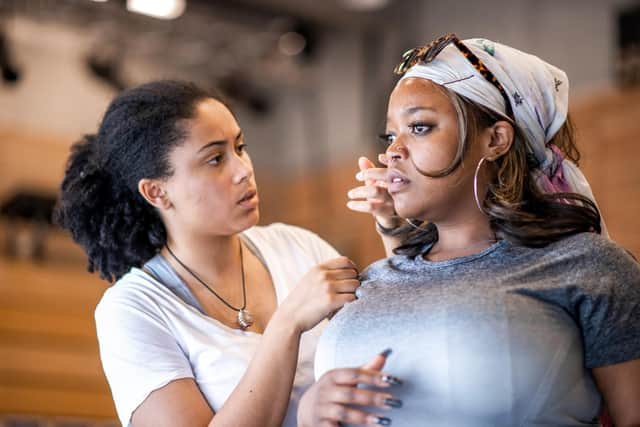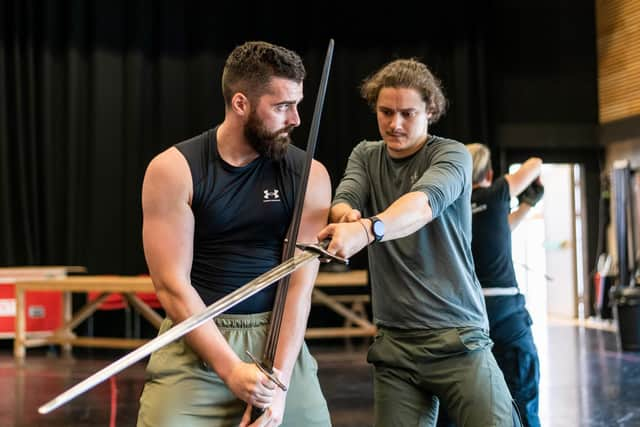Rona Munro on James IV: 'I’m interested in groups whose voices we’ve not heard'


A royal procession winding up the Royal Mile, the full splendour of monarchy on display, respectful silence or cheers as the pageant passes, and a few dissenters shouting abuse. It’s a drama that has played out over the centuries, at the heart of Scotland’s capital, and that suddenly reappeared earlier this month, following the death of the Queen at Balmoral. And it carries special meaning for playwright Rona Munro and director Laurie Sansom, as they rehearse a cast of 11 actors in Munro’s new play James IV: Queen Of The Fight, set to open at the Festival Theatre – just yards from the High Street – later this month.
For not only is James IV the latest play in Munro’s series about Scotland’s Stewart dynasty; it’s also a drama that revolves around the theatre and spectacle of monarchy, and how James IV sought to use it. “Some of the action in the play would have taken place on that very street, in scenes not so very different from what we’ve witnessed in recent days,” explains Munro; “and it’s so fascinating to be making a play about the great shows and spectacles James created in Edinburgh, at this of all moments.”
Advertisement
Hide AdBest known for contemporary dramas including Bold Girls (1990), set among women in Belfast during the Troubles, as well as for historical dramas The Maiden Stone and The Last Witch, Munro has long had an ambition to introduce audiences in Scotland and beyond to the relatively little-known story of the Scottish state between 1400 and the Union of Crowns in 1603. This was the age of the Jameses, the Stewart dynasty whose earlier history disappeared from the dominant narrative when James VI of Scotland became James I of Great Britain; and in 2014, backed by the Edinburgh International Festival, the National Theatre in London, and the National Theatre of Scotland, Munro and Laurie Sansom – then artistic director of the NTS – launched the James Plays trilogy, an epic series of plays covering the reigns of James I, II and III, and presented by a formidable company of 25 actors.


The trilogy played to packed audiences during the Edinburgh Festival of 2014, and was later acclaimed in London, and on tour to Canada and Australia. Munro, though, still had more to say about the Stewarts and their fate; and now, the Glasgow based company Raw Material are combining with Edinburgh’s Capital Theatres (in association with the NTS) to produce the fourth instalment of the series, while Hampstead Theatre is about to stage Munro's new chamber drama Mary, a fiercely feminist account of the reign of James IV’s famous granddaughter, Mary Queen of Scots.
Munro had already explored a wide range of theatrical styles in the original trilogy; and in James IV she promises something different again, as she explores the vivid cultural life of James’s court, and particularly the role in it of a group of black and Moorish courtier-performers whose existence is noted in the records, and in a searingly racist poem by court poet William Dunbar.
“I think what we’re making here is something like a backstage drama,” says Munro, “where you can see both the fantastic spectacles and pageants that were created during James IV’s reign, and the huge political and personal dramas that played out behind the scenes. As a playwright, I’m always interested in groups whose voices we’ve not heard before, or not heard enough.
“But that doesn’t mean that I’m shoe-horning black characters into a story that was historically all white. These characters absolutely existed, and are listed in the records of James’s court; and the fact that we’ve been brought up to think of our history as entirely populated by white people is just another aspect of racism and colonialism, and the myths it sought to impose.”


Munro’s new drama centres on the figure she calls Ellen, a Moorish woman who often played a central role in James’s spectacular shows and tournaments; hence the play’s subtitle, Queen Of The Fight. And like her forthcoming smaller-scale drama Mary – set to tour Scotland next year, after its Hampstead premier with a cast that includes Shetland star Douglas Henshall – it places the experience of women centre-stage, even when, as in the case of Mary, that means confronting the Queen’s horrifying rape and exploitation by the man history calls her third “husband”, the Earl of Bothwell, and her subsequent terrible public humiliation.
Advertisement
Hide Ad“I find that when you tell women, without naming names, exactly what happened to Mary in the last year before her flight to England, they are absolutely shocked by the story. That’s a measure of how far the history we inherit tends to discount violence against women; and that tendency to scapegoat women and global majority people, and to write the violence they suffer out of history, is also a factor in Queen Of The Fight.”
Laurie Sansom, now director of the Halifax-based Northern Broadsides company, has returned to Scotland to direct James IV; and both he and Munro agree that the events of recent weeks have given a strange and timely edge to the story.
Advertisement
Hide Ad“What never really works, though”, he adds “is if you try to change the history to fit the play. Of course, the details of the scenes, the relationships and conversations, have to be works of imagination. But the historical framework has to be accurate, otherwise the whole thing begins to lose emotional power. That’s what we found when we were working on the trilogy; and we’re striving to get that balance right again now , for James IV.”
James IV is at the Festival Theatre, Edinburgh, from 30 September until 8 October, and on tour until 12 November to Glasgow, Dundee, Inverness, Aberdeen and Stirling, see www.capitaltheatres.com/whats-on/all-shows/james-iv-queen-of-the-fight/41#tour Mary is at Hampstead Theatre, London, from 21 October until 26 November, and on tour in Scotland in 2023.